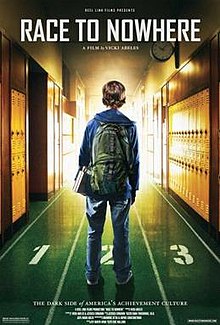Irvington PTSA Presents: Race To Nowhere

February 25, 2019
On Feb. 22, Irvington PTSA organized a showing of Race To Nowhere, a 2009 film that highlights the stress placed on American students due to competitiveness and overscheduling in our modern education system. The PTSA has shown this movie around three times in the last six years to spark discussion between students, parents, and the administration about the stress that Irvington’s students are experiencing.
The film points out that education has fixated on student performance, be it on a local level of school rankings, or on the global scale of international academic placement. According to teachers featured in the movie, this fixation fundamentally distorts parts of the education system. In the film, an AP Biology teacher said that he knows it is not possible to get through the entire book in one year. Although AP courses are “college-level courses,” this brings up the question of why some advanced high school courses are designed for the test rather than the material. As that teacher puts it, the curriculum is a “mile long and an inch deep,” forcing kids to think in certain patterns to solve problems narrow in scope. The film also shows how high school graduates are often underprepared for college courses, defeating the purpose of AP classes.
A common stressor at Irvington is the pressure to “get into a good college,” and fear of stigma surrounding the alternative; for example, a couple parents say in the film that they may as well disown their kids if they wind up at a community college. While this seems an extreme view, there is a lot of similar judgement surrounding community college here in Irvington when it would be much more healthy to simply view it as another option. This fear is often the rationale upon which kids overload and overwhelm themselves. Staying competitive is smart and necessary, but a culture where students do things for the sake of college apps is unhealthy.
This kind of learning environment affects parents, too. In the film, even those advocating against the system admit that they can’t help worrying whether their own kids are doing enough to be accepted into a good college. In some cases, parents impose their worries onto their children by pushing them to take on more than they can handle. This kind of upbringing in turn influences kids to force pressure inward. The film did seem a little extreme in describing the extents to which students worry about their grades or scores. Yet while a big part of students’ stress is self-induced pressure, and they do have the power to change their own thinking, it is also true that those thought processes are often a reflection of what kids are conditioned to think by society and/or parents while growing up.
Devoted teachers also have a tough time. As shown by the film, teachers are not necessarily able to teach what they believe in, but instead must teach what the district wants. This frustration caused one English teacher to eventually resign. It does not help that teachers are not placed in a high regard by the community through either prestige or pay.
One potential solution that the film suggests is a no-grading policy that would alleviate the majority of students’ anxiety from grades and test scores. Students could receive help from teachers on their problem areas, without the stress of receiving the score or pass or fail that so often hinders learning. The film also describes a school that cut its homework load—and saw AP test scores rise. This could be a more realistic approach to our own school district’s efforts to prevent overwhelmingly stressed students, and would actually result in better test performance. Without making some fundamental changes, a teacher in the film says, there is no point in funding schools in efforts to improve education.
This movie showing was followed by a 15-minute community discussion. Three Irvington students answered questions from the audience about their definition of success and their experience in a stressful school environment. Though the turnout of mostly parents, teachers, and a few students was fairly small, parents expressed how they wanted a district-mandated effort for this film to reach more people at different schools. The fact that this film is almost more relevant in today’s educational environment than when it was made ten years ago means that re-evaluation and change must happen before students’ futures become, essentially, a race to nowhere.








